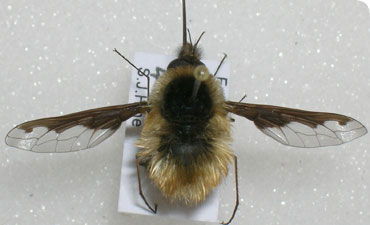Bee-fly
The nectar-loving bee-fly is found in country gardens and deciduous woodland where it is often mistaken for its look-alike, the bee.
Bee-fly
Diptera: family Bombyliidae
Identification
In the British Isles there are several species of hairy flies that resemble bees. The bee-like appearance is enhanced by their swift, darting flight, which is usually accompanied by a shrill hum. The difference is that bee-flies have only a single pair of functional wings whereas bees themselves have two pairs coupled together with minute hooklets.
The wings of the bee-fly are characteristically patterned, with a broad, chocolate-brown band extending along the leading edge of the wing from base to apex. The body is densely covered in rich brown hairs but this colour fades and the hairs are easily rubbed away, leaving old specimens partly bald. The proboscis or tongue is especially prominent, as it is long, projecting and non-retractable. The legs are also long and thin.
Distribution
The most common species of bee-fly throughout much of southern Britain is Bombylius major, a springtime species that flies from late March to the end of May. This insect is most frequently found in open deciduous woodland and in large country gardens, but it also occurs sporadically on the coast.
This insect is often seen hovering around flowers of some low-growing plants, such as primrose, bugle or violet, with its proboscis thrust deep into the flower to reach the nectary. Throughout feeding the wings continue to beat, and the delicate legs support the fly as it perches on the flower. At other times females are observed quartering the ground, particularly sparsely vegetated soil, in their quest for the nests of mining bees.
Behaviour
British bee-flies attack one or two species of bee and wasp, both the nests and solitary adult members. B. major attacks the nests of several species of mining bees. When a nesting burrow is located, the fly hovers near the entrance and, from time to time, dips the tip of its abdomen into the surface of the soil to lay the eggs. The larvae, that later hatch out, move into the bee nest to feed on the bee larvae.
Other species
The other Bombylius species found in Britain are B. discolor, B. canescens and B. minor, although none of these are common. B. discolor is another springtime species, easily identified when at rest by its speckled wings and white stripe down the centre of its abdomen. The other two species have unmarked wings and fly from late May to July or August.
The remaining British bee-flies are Phthiria pulicaria, Villa modesta, V. circumdata, V. cingulata, Thyridanthrax fenestratus and Anthrax anthrax. These are all very uncommon or rare species. However, V. modesta is sometimes found in higher numbers on coastal sand dunes from June to September. T. fenestratus occurs mainly on sandy heath lands in southern England. It is active from June to late August.
Living with humans
Bee-flies not only resemble bees but the larvae of some species also live in the nests of solitary “mining bees”. The flies are harmless to humans as they don't bite or spread organisms that cause disease.
Toolbox

Last year nearly 100,000 specimens were loaned to scientific institutions and researchers worldwide.

